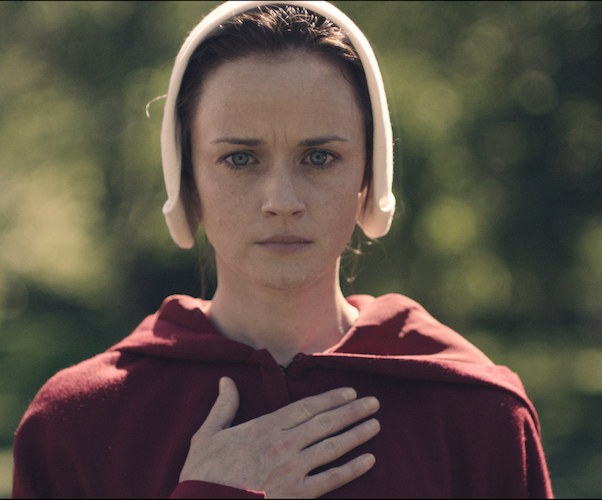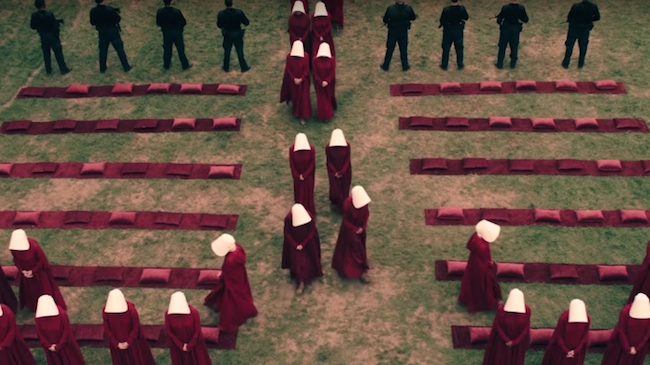Television Review: “The Handmaid’s Tale” — Not a Documentary…Yet
Margaret Atwood’s novel turns out to have been far more clairvoyant than even she believed it would be.

Alexis Bledel in “The Handmaid’s Tale.”
The Handmaid’s Tale, Adapted from the novel by Margaret Atwood. On Hulu.
By Peg Aloi
The much-anticipated Hulu series based on Margaret Atwood’s dystopian novel from 1985 does not disappoint expectations; in fact, it delivers an aptly horrifying and prescient treatment of the story’s increased relevance. You see, for women, the personal is the political, and vice versa. I was reminded of this while recently re-viewing the excellent documentary She’s Beautiful When She’s Angry, which chronicles the birth of the women’s movement of the late 1960s. In recent months, American women have seen rising complacency about sexist behavior as well as the normalizing of misogynist rhetoric. There is also a threat to our hard-won reproductive rights. The chatter around this new series has been enlivened by its eerily-accurate reflection of our present situation, which may yet escalate into a future not unlike the one depicted in this television adaptation.
Atwood’s novel was published to rave reviews and devoured by feminists, science fiction fans, and curious readers around the world. In the Republic of Gilead, in the not too distant future, women have lost all rights to their bodies, their reproductive autonomy, their livelihoods, and even their names. Atwood’s novel is narrated in the first person by Offred, a young woman whose name at first seems a comment on the bright red robes — flamboyant yet puritanical — that she and others like her are forced to wear. We soon realize women are referred to by the names of their fathers: “Ofglen” or “Ofwarren.” They have no jobs, are not allowed to own property, read books, or watch television. And oh, by the way, the young fertile ones are forced to bear children for complete strangers.
The book was adapted into a film in 1990, only five years after it debuted to rave reviews. With a screenplay by British playwright Harold Pinter and direction by German filmmaker Volker Schlöndorff (most famous for 1979’s The Tin Drum) the film starred Miranda Richardson as Offred; Faye Dunaway and Robert Duvall were the government officials who use her as a surrogate. The film was well received critically, but at that time it had an air of implausible speculative fiction about it. After all, Roe v. Wade was only a decade and a half old, and the Moral Majority was in its infancy. But Atwood’s novel turns out to have been far more clairvoyant than even she believed it would be.
The series begins with a young woman and her husband and daughter on the run in their car on a remote road. We later learn this is June (Elisabeth Moss, of Mad Men, Top of the Lake, and many films) and husband Luke (O-T Fagbenle). The car crashes, the sirens loom closer, and Luke tells his wife and daughter to run to a meeting point two miles away; that he’ll be right behind her. Their goodbye is hurried; June barely gets thirty seconds into the woods before she hears gunshots. She hides with her daughter, at first escaping the armed men in pursuit; they eventually capture her and take her daughter away.
We then see June, now known as Offred, describing the small room she now lives in. This is her new reality. We see her brought to a “Red Center,” a place where handmaids are schooled in how to behave in their new roles as compulsory baby-makers. The matron running the center is Aunt Lydia (veteran actress Ann Dowd, seen recently in True Detective, is terrifyingly powerful here), and she’s as skilled in quoting scripture as she is in wielding a taser. Piety and brutality walk arm in arm in this brave new world. As she enters the world of the Handmaids for the first time, an exhausted and terrified Offred catches a glimpse of her best friend, Moira (Samira Wiley), but the two cannot reveal they know each other. Surveillance is omnipresent, and being under “the Eyes” is a constant threat to private thoughts or outlawed behaviors (like swearing, lesbianism, eating sugar, or accessing media of any kind).
The first three episodes (available today, streaming on Hulu) take us deeply into the world that is Gilead, and reveals how we got there. In flashbacks, we see that women who dress in shorts and listen to music are called “sluts.” Women are relieved of their jobs en masse, their bank accounts seized. Martial law is declared in response to “terrorism” and armed men are everywhere, their radios blurting unintelligible but ominous words. Grocery stores display packaging that only has pictures, not words (literacy is an implied evil); in one scene, piped in elevator music and the clean white interior of the grocery store suggests a reference to that other woman-hating dystopian film, The Stepford Wives (1975).
Offred’s “partner,” with whom she walks to the market each day, is Ofglen (Alexis Bledel, in a compelling performance). She is suspected to be a “true believer” — they are polite and diffident with each other. But one day, after a brutal public ceremony in which the Handmaids are encouraged to punish a known rapist, Oglen and Offred let their guards down and begin to learn more about each other. This spirit of sisterhood is cut brutally short, however. The community that the women inhabit is infused with paranoia and betrayal.
One reason The Handmaid’s Tale (written by Bruce Miller, who also co-produced sci-fi series The 4400 and The 100 and is working on Jenji Kohan’s new series about the Salem Witch Trials, The Devil You Know) resonates strongly today is that the flashback scenes (memories of the world referred to as “Before”) take place in what looks very much like the present day: hip hop music plays on iPods, cafes serve complicated low-fat coffee drinks, an intimidating military presence makes use of semi-automatic rifles and wears black knit hats in the mode of Colorado hipsters, people buy used Volvos on craigslist. But there are differences: fascism is approaching, but the characters can’t quite believe it is taking place. When anger builds and there are marches and demonstrations, the police/military (there’s no real separation between the two anymore and, if you doubt this, see the recent documentary Do Not Resist) shoot unarmed protesters with impunity. Women are finally rounded up and reassigned according to their utility: as domestic servants (Marthas) or incubators (Handmaids). Known lesbians may be punished with “mercy” or “redemption”—I won’t spoil a particularly moving and harrowing scene by explaining those euphemisms further.

Scene from “The Handmaid’s Tale” on Hulu
The show’s cinematic scale is impressive, its lush visuals providing effectively disturbing juxtapositions, just as the excellent performances inspire empathy. Ostensibly set in Boston, expanses of green space are rare. The glimpses of nature are welcome respites to the oppressive houses the Handmaids live in, with their iron gates and high garrets, which let the sun in through narrow windows. The costumes are particularly well done, defining as they do the enforced roles of both the exploited and the privileged alike. The Handmaids’ red gowns are a deep blood red, (not the bright electric shade worn in the film version). Their white caps have an outer shell (referred to as “wings”) that hides their faces for modesty’s sake and makes hushed whispers of solidarity difficult. The “wives” of the “commanders” (the title given to men who work in government; business is apparently extinct) dress in cool shades of emerald green, hinting at wealth and greed, but also jealousy and envy.
The Handmaid’s duty is completed via bizarre ceremonies and rituals that center on impregnation and birth; the arrangement is strange, intimate, and humiliating for all involved. The overarching purpose is to serve God; but religion is an oddly cold and distant presence here. Offred is frequently heard speaking to God for help; but the constant anachronistic phrases uttered by the denizens of Gilead (“blessed be the fruit,” or “go with grace” or “praise be,” or even “under His eye,” which also refers to the “eyes” of surveillance) ring hollow given the violence and tyranny that govern America’s hypocritical culture. Those who managed to escape to Canada when things started changing are the lucky ones. In Atwood’s novel, Japanese tourists come to gawk at the strangely dressed and morally backwards citizens of Gilead. In one of several bold — but intriguing — changes to Atwood’s work, this society is a multi-cultural one. June and Luke have an interracial marriage, white June’s best friend Moira is African-American. In the 1985 novel, the new regime “rounded up” people of color and relocated them to Midwest camps.
I wondered if the change from Atwood’s novel could have been more powerfully done. After all, racist policies are currently being directed towards American immigrants; it would make sense that Gilead’s brand of authoritarianism would attempt to control to all expressions of the Other, not just women. Still, there are examples of the indignity of social rank, based on socioeconomic and class status. The handsome driver who works for Offred’s “Commander” is of “such low status” that he has not yet been “assigned a woman.” Meanwhile, the treatment of the people who protest the government — men, women, young, old, every race imaginable — is egalitarian. The spray of bullets that sends them fleeing for cover is remarkably democratic in its range and efficacy. As Offred says, “There will be no mercy for members of the resistance.”
Peg Aloi is a former film critic for The Boston Phoenix. She has taught film studies for a number of years at Emerson College and is currently teaching media studies at SUNY New Paltz. Her reviews have appeared in Art New England and Cinefantastique Online.
Tagged: Alexis Bledel, dystopia, Hulu, Margaret Atwood, Peg Aloi
